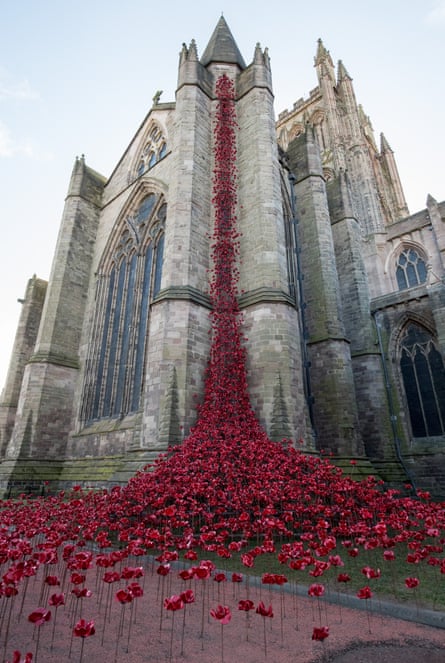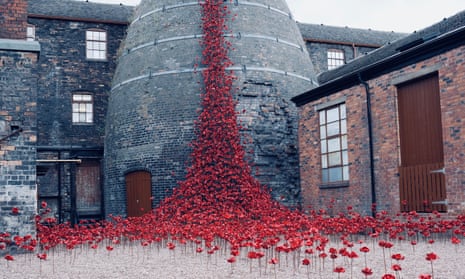Poppies: Blood Swept Lands and Seas of Red captured the public’s imagination like no other art installation, so it is fitting that it will form part of national commemorations to mark 100 years since the Armistice.
Two sculptures from the artwork – Wave and Weeping Window – will go on display at the Imperial War Museums in London and Manchester at the culmination of a four-year tour during which they have been displayed at locations across Britain.
The initial installation was created at the Tower of London to mark the centenary of the outbreak of the first world war, and comprised 888,246 ceramic poppies, one for every British or colonial life lost at the front.
The poppies, each handcrafted, painted and placed by volunteers, were sold individually to members of the public, raising £9.5m for six military charities, and seen by more than 5 million people at the Tower of London between July and November 2014.
Over the past four years, a further 4 million people have seen Wave and Weeping Window installations at 16 historic sites, memorials, museums, town halls and places of worship. On Saturday, Wave will be unveiled at the IWM North in Manchester, and remain on display until 25 November, while Weeping Window can be seen at IWM London from 5 October until 18 November.
A book, including striking images charting the journey of the poppies from installation at the tower through to the end of their UK tour as part of 14-18 NOW, is being published this week.

Diane Lees, the director general of IWM, said the installation at the Daniel Libeskind IWM North building would look “completely stunning”.
“This amazing building is built as a configuration called Shattered Earth. The shards are a planet broken apart by conflict. So to have something as symbolic as the poppy wave over the building is just the perfect sign off to the first world war centenary,” she said.
Both installations have looked different at every site. Now gifted to the IWM, there are plans for a permanent display, as well as a mobile display that can be easily shipped overseas for future commemorations and events. “There is huge international interest in them,” Lees said.
“They are such a phenomenon. I cannot think of another example where the public and nation have got behind a single art installation in that way. So, it is not surprising that there is interest, particularly from the Commonwealth countries to share something of that narrative.”

She added: “You can imagine at every anniversary having the poppies out on display. They are going to become part of Remembrance going forward. So I think they have an amazing legacy.”
The artist Paul Cummins said the public reaction to the artwork had been “incredible, something quite beyond what I ever expected, and it has been a journey for myself seeing people’s interactions with Wave and Weeping Window at the various locations around the UK”.
The designer Tom Piper said: “With Blood Swept Lands and Seas of Red we wanted to create something different – something that represented the tragic loss of life but also the spirit and energy embodied by the people who died in conflict.”
